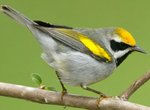Birds, specifically golden-winged warblers in the eastern Tennessee mountains, fled their breeding grounds one to two days before a series of tornadoes hit the area killing 35 people, a study led by UC Berkeley ecologist Henry Streby found.
The team included researchers from the University of Tennessee, the US Geological Survey, and the University of Minnesota.
Post-doctoral fellow Streby said:
“It is the first time we’ve documented this type of storm avoidance behavior in birds during breeding season.”
Previous studies had found that birds may alter their route to avoid natural phenomena during regular migration. However, this is the first investigation to show that they might also leave after the migration is over and they have established their breeding territory – to get away from imminent severe weather.
Streby said:
“The warblers in our study flew at least 1,500 kilometers (932 miles) total to avoid a severe weather system. They then came right back home after the storm passed.”
When the birds fled, evidence suggesting that severe weather was on the way – including changes in wind speed, temperature and atmospheric pressure – was largely absent.
The team said that while meteorologists on the Weather Channel were telling viewers that a storm was heading their way, the birds were apparently already packing their bags and fleeing.
Their study has been published in the journal Current Biology.

A male golden-winged warbler with a geolocator on its back and ID bands on its legs (Photo: newscenter.berkeley.edu)
An accidental discovery
The researchers had been studying the birds’ migratory pattern and were not specifically looking out for any behaviors related to what eventually occurred.
Golden-winged warblers spend their winters in Central and South America, after which they migrate to The Appalachian Mountain and Great Lakes regions to breed.
While population levels of this bird are about normal in the Great Lakes, in the Appalachians they are only at 5% of historic levels, due to hybridization with other species and habitat loss.
The team were trying to determine whether such tiny birds – golden-winged warblers only weigh about 9 grams – could successfully carry a tiny geolocator all year round.
To get the tracking data, they had to retrieve as many geolocators as possible from the 20 warblers that had been tagged originally. They managed to obtain five.
Streby explained that these warblers were the smallest bird species ever to have geolocators. “The fact that any geolocators came back at all was a relief,” he said.
After gathering and studying the data, the team found anomalies in the geographical locations of the birds from April 26th to May 2nd. They had flown back from their breeding grounds in Tennessee’s Cumberland Mountains to the Gulf coast.
This was unusual behavior, because warblers tend to stay put as soon as they have reached their breeding grounds to raise their young.
At first, the team thought there was something wrong with the readings. After double and triple checking, they could not find any errors in the geolocator data. So they started to look for an explanation.
Streby said:
“We remembered the supercell storm because we also had to evacuate to a hotel to wait it out.”
However, although linking the warbler’s fleeing behavior to the imminent storm made sense, the researchers were initially baffled. How could they have known? The most logical explanation was “infrasound”.
Infrasonic sounds of Earth
Infrasound refers to sound waves with frequencies below the lower limit of human hearing, which is below 20 hertz (cycles per second).
Several animals, including birds, can hear infrasound. In fact, whales, elephants, hippopotamuses and rhinoceroses can produce sounds well below our range.
Natural occurrences, such as ocean waves crashing onto shorelines, volcanoes erupting and wind blowing over mountains produce infrasounds that can travel thousands of miles. Very low frequency sounds can travel very far – the lower the frequency, the further they can reach. When an atomic bomb explodes, the infrasound produced can be detected across the planet.
Tornadoes produce very strong infrasound. We know that birds respond to infrasound frequencies.
A 2000 study carried out by geophysicist Jon Hagstrum showed that Concorde’s infrasound could interfere with racing pigeons’ ability to find their way home.

Birds’ ability to detect distant storms could become vital as tornadoes become more frequent, Streby said. (Photo: Berkeley.edu)
Hagstrum said this latest study showed compellingly that birds use infrasound to detect distant storms.
Hagstrum said:
“Biologists had not been looking at the use of infrasound in this way, but it certainly makes sense to me. We may find that acoustics are a pretty significant way that birds in general view their environment, much like dogs use olfaction and humans use sight.”
With climate change likely to bring more tornadoes, this newly discovered ability that birds have could become increasingly important for their survival, the authors said.
Streby explained
“There’s growing research that shows that tornadoes are becoming more common and severe with climate change, so evasive actions like the ones the warbler took might become more necessary. It could come at a cost, though, since such actions place added energetic and reproductive stress on populations that are already struggling.”
The US Geological Survey and the US Fish and Wildlife Service helped support this study.
Citation: “Tornadic Storm Avoidance Behavior in Breeding Songbirds,” Henry M. Streby, Gunnar R. Kramer, Sean M. Peterson, Justin A. Lehman, David A. Buehler3, David E. Andersen. Current Biology. 18 December 2014. doi:10.1016/j.cub.2014.10.079

